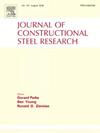冷弯型钢(CF-CFS)柱受压时截面阻力:EN 1994-1-1的设计方案
IF 4
2区 工程技术
Q1 CONSTRUCTION & BUILDING TECHNOLOGY
引用次数: 0
摘要
本文通过对1084个有限元模型的广泛数值分析,研究了新型冷弯型钢混凝土组合柱的抗压性能。研究评估了组合柱体系中组合梁截面和混凝土构件的各自贡献。有限元模型与试验结果吻合良好。然后,基于校准和验证的模型进行参数化研究。结果表明,混凝土的轴向贡献可以准确地表示为其抗压强度占其横截面积的比例。对于组合式CFS截面,采用改进的有效宽度法确定轴向阻力,该方法考虑了包壳板的总面积和外板的有效面积,并根据板的位置和紧固条件调整了屈曲系数kσ。所提出的方法与en1993 -1-3的假设不同,它考虑了组合CFS截面的屈曲行为。修正后的方法能准确预测CF-CFS复合短柱的轴向承载力,预测结果与计算结果的平均比值为1.04,变异系数(COV)为0.036。这些发现为CF-CFS复合柱的设计提供了一种强大而实用的方法,为EN 1994-1-1在未来结构工程实践中的扩展应用铺平了道路。该研究强调了考虑混凝土约束效应和复合系统中CFS板之间相互作用的重要性,为未来的设计标准提供了一个强大的框架。本文章由计算机程序翻译,如有差异,请以英文原文为准。
Sectional resistance of built-up concrete-filled cold-formed steel (CF-CFS) columns under compression: Design proposal for EN 1994-1-1
This study investigates the compressive resistance of innovative concrete-filled cold-formed steel (CF-CFS) built-up composite columns through an extensive numerical analysis of 1084 finite element models. The research evaluates the individual contributions of the built-up CFS cross-section and the concrete-filled component within the composite column system. The finite element models were validated against experimental tests, demonstrating excellent agreement. Then, the parametric study was performed based on calibrated and validated models. The results show that the axial contribution of the concrete can be accurately represented as its compressive strength to its cross-sectional area. For the built-up CFS section, the axial resistance was determined using a modified effective width method, which considers the gross area for encased plates, the effective area for outer plates, and adjusted buckling factors kσ based on plate location and fastening conditions. The proposed method accounts for the buckling behavior of built-up CFS sections, which differs from the assumptions in EN 1993-1-3. The modified method accurately predicts the axial capacity of CF-CFS composite stub columns, with an average ratio of FE-to-predicted results of 1.04 and a coefficient of variation (COV) of 0.036. These findings offer a robust and pragmatic design approach for CF-CFS composite columns, paving the way for an expanded application of EN 1994-1-1 in future structural engineering practices. The study highlights the importance of considering the confinement effect of concrete and the interaction between CFS plates in composite systems, offering a robust framework for future design standards.
求助全文
通过发布文献求助,成功后即可免费获取论文全文。
去求助
来源期刊

Journal of Constructional Steel Research
工程技术-工程:土木
CiteScore
7.90
自引率
19.50%
发文量
550
审稿时长
46 days
期刊介绍:
The Journal of Constructional Steel Research provides an international forum for the presentation and discussion of the latest developments in structural steel research and their applications. It is aimed not only at researchers but also at those likely to be most affected by research results, i.e. designers and fabricators. Original papers of a high standard dealing with all aspects of steel research including theoretical and experimental research on elements, assemblages, connection and material properties are considered for publication.
 求助内容:
求助内容: 应助结果提醒方式:
应助结果提醒方式:


